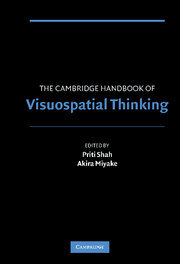Book contents
- The Cambridge Handbook of Visuospatial Thinking
- The Cambridge Handbook of Visuospatial Thinking
- Copyright page
- Contents
- List of Contributors
- Preface
- Acknowledgments
- 1 Functional Significance of Visuospatial Representations
- 2 Visuospatial Images
- 3 Disorders of Visuospatial WorkingMemory
- 4 Individual Differences in Spatial Abilities
- 5 Sex Differencesin Visuospatial Abilities
- 6 Development of Spatial Competence
- 7 Navigation
- 8 Mapping the Understanding of Understanding Maps
- 9 Spatial Situation Models
- 10 Design Applications of Visual Spatial Thinking
- 11 The Comprehension of Quantitative Information in Graphical Displays
- 12 Multimedia Learning: GuidingVisuospatial Thinking with Instructional Animation
- Author Index
- Subject Index
12 - Multimedia Learning: GuidingVisuospatial Thinking with Instructional Animation
Published online by Cambridge University Press: 05 June 2012
- The Cambridge Handbook of Visuospatial Thinking
- The Cambridge Handbook of Visuospatial Thinking
- Copyright page
- Contents
- List of Contributors
- Preface
- Acknowledgments
- 1 Functional Significance of Visuospatial Representations
- 2 Visuospatial Images
- 3 Disorders of Visuospatial WorkingMemory
- 4 Individual Differences in Spatial Abilities
- 5 Sex Differencesin Visuospatial Abilities
- 6 Development of Spatial Competence
- 7 Navigation
- 8 Mapping the Understanding of Understanding Maps
- 9 Spatial Situation Models
- 10 Design Applications of Visual Spatial Thinking
- 11 The Comprehension of Quantitative Information in Graphical Displays
- 12 Multimedia Learning: GuidingVisuospatial Thinking with Instructional Animation
- Author Index
- Subject Index
Summary
Visuospatial thinking occurs when someone forms a mental image and manipulates it in a principled manner. Multimedia presentations – messages consisting of words and pictures – can be designed to prime appropriate visuospatial thinking during learning, which in turn leads to deeper understanding. This chapter examines the theoretical and empirical support for this assertion by describing a cognitive theory of multimedia learning, reviewing the history of attempts to use technology to support visuospatial thinking, summarizing research on eight design principles for fostering visuospatial thinking in multimedia learning, and briefly examining exemplary projects aimed at fostering visuospatial thinking in educational contexts.
Keywords
- Type
- Chapter
- Information
- The Cambridge Handbook of Visuospatial Thinking , pp. 477 - 508Publisher: Cambridge University PressPrint publication year: 2005
- 13
- Cited by

